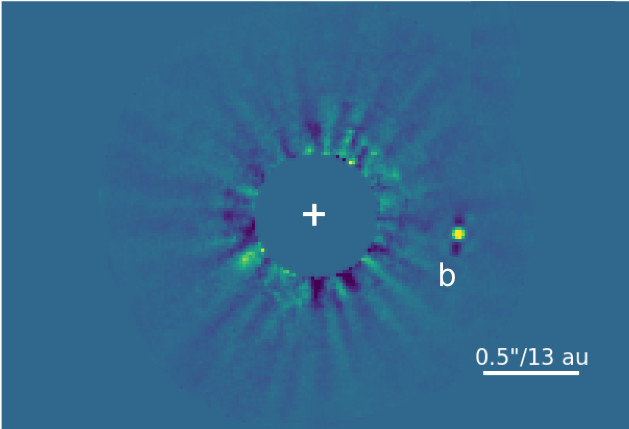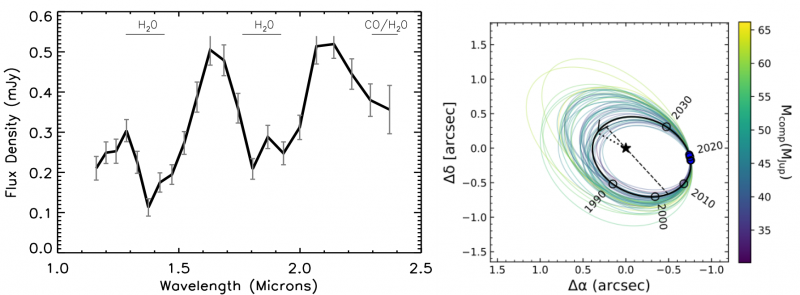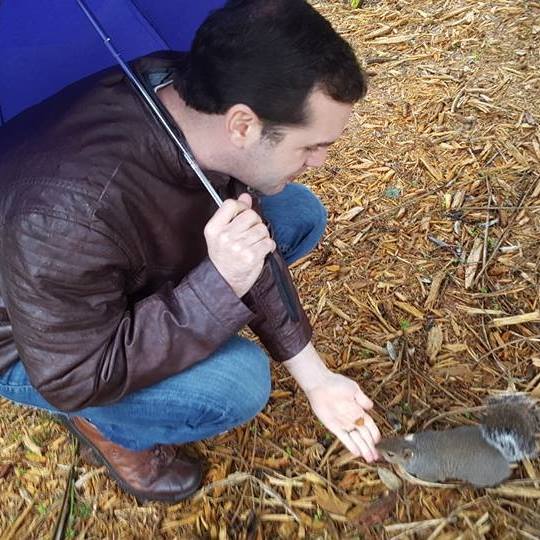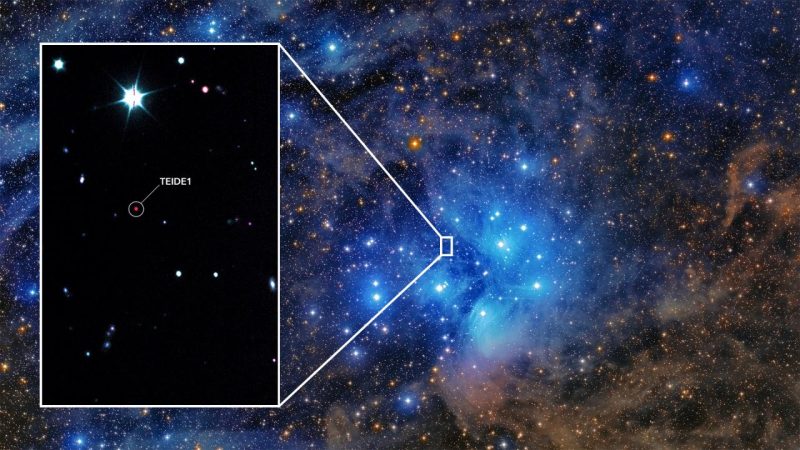
Brown dwarfs are star-planet hybrids, falling somewhere between the masses of giant planets like Saturn and Jupiter, and the smallest stars. All the brown dwarfs we know are outside our own solar system, and they are very dim; their great distances and general dimness makes them hard to photograph directly. In December, though, astronomers using the Subaru Telescope and the Keck Observatory in Hawaii released a new direct image of a brown dwarf that’s one of the best yet obtained. The brown dwarf, called HD 33632 Ab, orbits a sun-like star, HD 33632 Aa, which is 86 light-years away from our solar system.
The new peer-reviewed paper detailing the discovery was published by the researchers in The Astrophysical Journal Letters on November 30, 2020.
By definition, brown dwarfs have between 13 and 80 times the mass of our solar system’s largest planet, Jupiter. That’s the mass range in which a form of thermonuclear fusion – a “burning” of deuterium, a rare element left over from the Big Bang – can occur in an object’s interior. HD 33632 Ab is about 46 times Jupiter’s mass. It orbits at about 20 astronomical units (Earth-sun distance units, aka AU) from its star. That’s similar to the distance from our sun to the planet Uranus.
After this object’s initial detection by the Subaru telescope, astronomers used the Keck telescope to conduct additional observations. They wanted to make sure that the object really was orbiting the star and wasn’t actually a different star completely unrelated to HD 33632 Aa. They discovered the brown dwarf initially not by seeing it, but by measuring a slight acceleration of the companion star due to brown dwarf’s gravitational pull. Those measurements were made by the Gaia astrometry satellite and its predecessor astrometry mission, Hipparcos. Co-author Timothy Brandt at the University of California, Santa Barbara, commented:
This is the first time we have found a brown dwarf by looking around a star that is being tugged across the sky. Finding a brown dwarf always involves luck, but this time we were able to stack the odds.

The new image of this brown dwarf used a technology called adaptive optics at both Subaru and Keck. This technology removes blurring from images caused by ground-based telescopes peering through Earth’s atmosphere. It lets better images be obtained. The researchers also gathered data on the composition of the brown dwarf’s atmosphere. Thayne Currie, an affiliated researcher at Subaru Telescope and lead author of the study, stated:
… we can not only see HD 33632 Ab but get ultra-precise measurements for its position and its spectrum, which gives important clues about its atmospheric properties and its dynamics.
Astronomers say they’ve found evidence for water and carbon monoxide in HD 33632 Ab’s atmosphere.

They say the discovery and analysis of this brown dwarf provides them with valuable data about brown dwarfs in general, and more clues as to how they are born and evolve. But also, the data can be extrapolated to exoplanets as well. In particular, the HR 8799 planetary system of four planets larger than Jupiter, the first system of more than one planet to have its picture taken. The temperatures of these worlds are estimated to be similar to those of HD 33632 Ab, which allows scientists to compare the atmospheres. Currie said:
Keck Observatory’s NIRC2 thermal infrared data allowed us to better understand how HD 33632 Ab’s atmosphere compares to those of the first directly imaged exoplanets, HR 8799 bcde, which were discovered in part by Keck.
Such comparisons can shed light on how both exoplanets and brown dwarfs form and evolve, even though – because their masses are different, and thus they evolve and behave differently – they are distinctly different objects. Some known exoplanets are significantly more massive than our solar system’s biggest planet, Jupiter. But brown dwarfs are more massive still, just not large enough to burn hydrogen in their interiors and thus to shine as stars do. So brown dwarfs fill a gap between planets and stars. They are unique worlds, with atmospheres, neither stars nor planets.


The first brown dwarf, Teide 1, was discovered in the Pleiades star cluster, 400 light-years away, back in 1995. It was found by astronomers at Instituto de Astrofísica de Canarias (IAC) using the IAC-80 telescope at the Teide Observatory in the Canary Islands. Teide 1 has a radius similar to Jupiter, but is 55 times more massive, with a surface temperature half that of the sun, at 2,600 K (about 2,300 degrees Celsius or 4,200 Fahrenheit). More than 1,800 brown dwarfs have been discovered since then. According to astrophysicist Rafael Rebolo López at IAC:
We know that there must be tens of thousands of millions in our galaxy, almost as many as the stars, something which we were bold enough to predict, even in the discovery article in Nature. There are far more of them floating freely in space than orbiting stars. Now we know how many of them there are in each mass range, and we know of examples over almost the full range of surface temperatures predicted by the theory, some of them have surface temperatures even lower than the mean temperature of the Earth’s surface.
Bottom line: Astronomers have obtained one of the best images yet of a brown dwarf, an object in a mass range midway between stars and planets. This brown dwarf – called HD 33632 Ab – lies 86 light-years from our sun.











